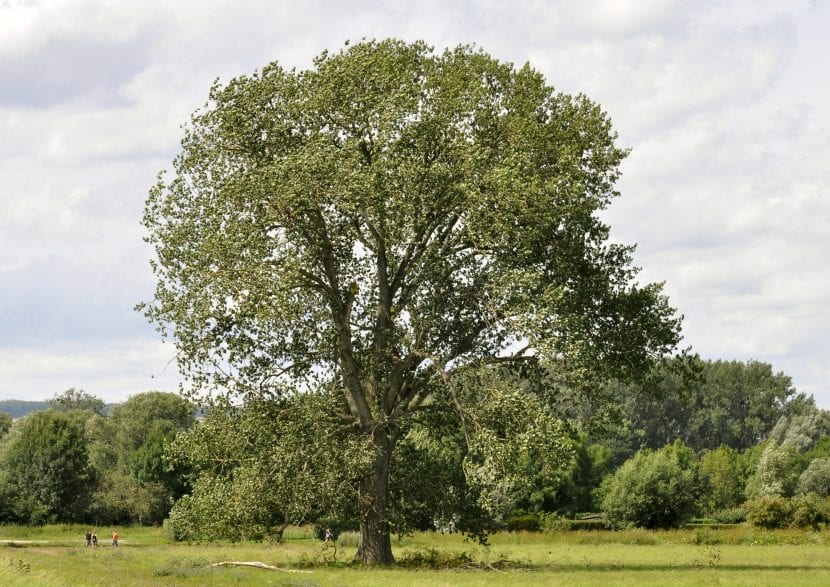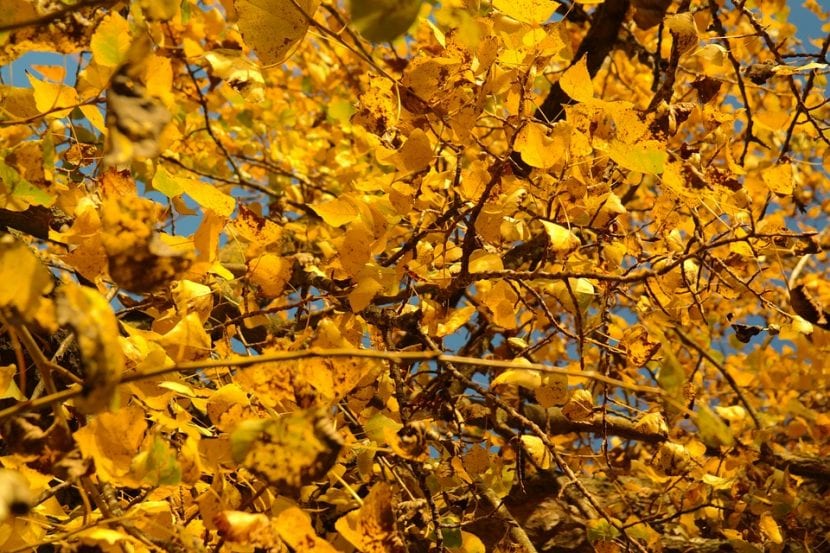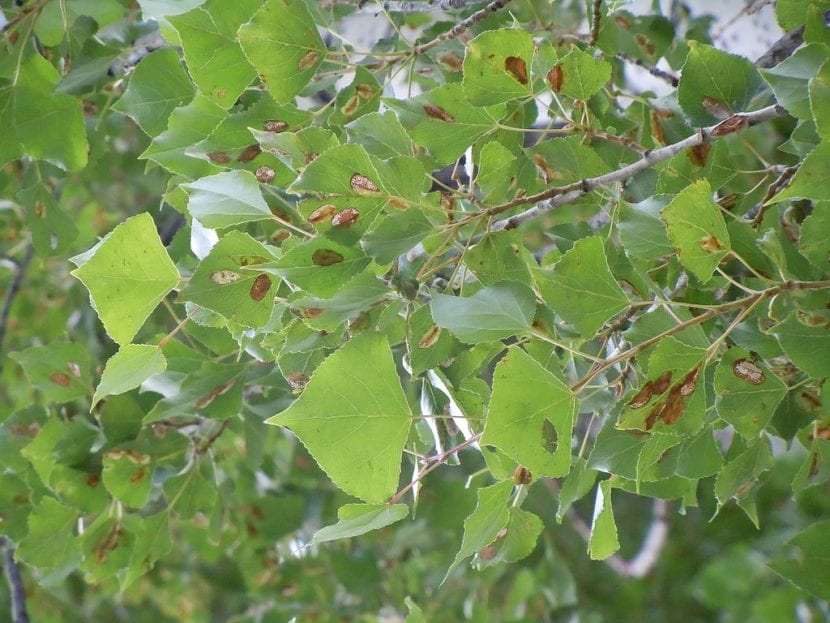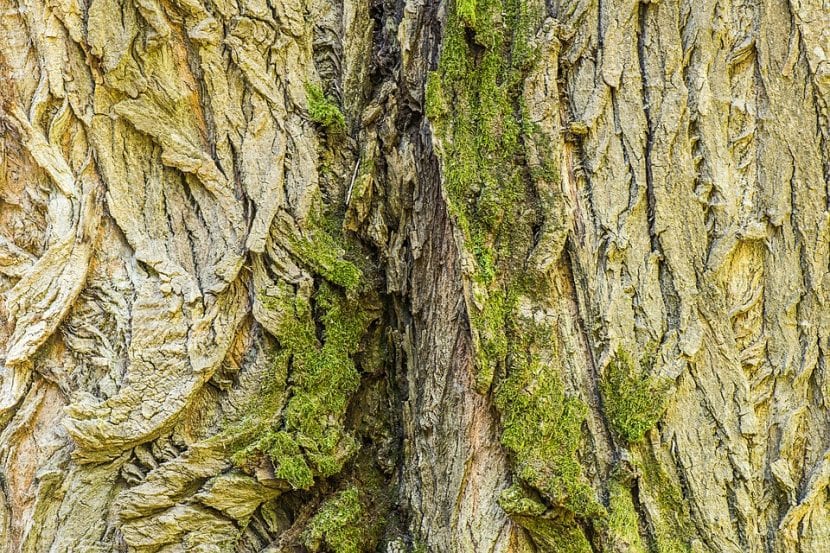
El black people it is one of the tallest deciduous trees that we can find in much of Europe, as well as in other regions of the northern hemisphere. Its great beauty and its rapid growth have also made it an ideal plant for spacious gardens.
Although it has some drawbacks that we will now see, it is a very interesting option when looking for an imposing tree.
Origin and characteristics

El black people, known as black poplar, black poplar, poplar or alameda, It is a deciduous tree that reaches a height of 20 to 30 meters. The trunk is normally straight, with a grayish bark that tends to crack early. The crown is wide, formed by ovate-triangular or ovate-rhombic leaves, with a size of 2 to 6 cm.
Its flowers, which are hanging catkins, sprout before the leaves, between the months of February and March in the northern hemisphere. The fruit is a capsule inside which are brownish seeds that are wrapped in white fluff that are disseminated in April-May.
It is native to southern, central and eastern Europe, central and western Asia (up to Siberia), and North Africa.
Subspecies
Four are known:
- Populus nigra subsp. black: grows in central and western Europe. The leaves do not have any hair, and the bark is grayish-brown.
- Populus nigra subsp. betulifolia: grows in northwestern Europe. The leaves and stems are somewhat pubescent, the bark is grayish-brown, thick, and the trunk usually slopes.
- Populus nigra subsp. caudine: grows in the Mediterranean region and in southwestern Asia.
- Populus nigra var. afghanistan: grows in Southwest Asia. The bark is almost white, soft to the touch.
Cultivars
There are many:
- Elegans
- pubescens
- Gigantea
- Italica: known as Lombard poplar.
What are their cares?

Image - Wikimedia / Matt Lavin
If you want to have a copy, we recommend you take care of it as follows:
Location
It is a tree that It must be outside, in full sun. In addition, it must be taken into account that its root system is very strong and deep, so that it is very necessary to place it at a distance of at least 7-8 meters from pipes, walls, etc. to avoid problems.
Earth
- Garden: accepts almost all types of soils, except saline. Even so, it prefers the fertile and humid ones.
- Flower pot: It is not a very suitable plant to grow in pots, although during its young years it can be grown with a universal growing medium.
Irrigation
The black poplar is a water-loving plant, but beware, without excesses. It can tolerate the waterlogging that occurs when it rains torrentially from time to time throughout the year, but it is not aquatic and therefore does not like to have "very wet feet" permanently. What's more, if we watered it daily, it would rot and die.
So, so that this does not happen, I advise you to check the humidity of the soil before watering. To do this, you can help yourself with a digital humidity meter, a thin wooden stick, or if you have it in a pot, weighing the pot just watered and again after a few days.
Thus, little by little you will see that you pour water an average of 4-5 times a week during the hottest and driest season of the year, and every 3-5 days the rest more or less.
Subscriber
Your nutritional requirements are very high from spring to late summer, but I do not advise using chemical fertilizers because although their effectiveness is very fast, they harm the environment. So, I personally recommend organic fertilizers, such as compost, guano (you can get it in powder here, and potting liquid for this link), or others that we all end up having at home and that we usually throw away (here you have some examples).
Anyway, in case you are interested, on the blog we wrote a very complete post about the different types of fertilizers, which you can read by clicking on this link.
Multiplication

El black people multiplies by seed in spring and cuttings in late winter. Let's see how to proceed in each case:
Seeds
- The first thing you have to do is fill a forest seedling tray or a pot of about 10,5cm in diameter with universal growing medium.
- Afterwards, it is watered conscientiously and sprinkled with copper or sulfur. This prevents the appearance of fungi.
- Then, the seeds are sown, putting a maximum of three in each socket / pot.
- They are then covered with a thin layer of substrate.
- Finally, it is sprayed with water, and the seedbed is placed outside in full sun.
Cuttings
To multiply it by cuttings, you have to cut a branch about 40cm long, impregnate the base with homemade rooting agents and then plant it in a pot with a universal growing medium. It usually takes root easily within a month or so.
Pruning
You can prune your black people in autumn or late winter. Cut off dry, diseased, weak branches and those that are broken, and trim those that are growing too much.
Planting or transplanting time
Late winter, when the risk of frost has passed. It tolerates bare root transplantation as long as it is done in that season.
In case of growing it in a pot, it must be transferred to a larger one every 2 years.
Rusticity
It resists frosts of up to -24ºC, but it does not live in tropical climates.
What uses does it have?

- Ornamental: it is a tree that is grown in gardens, either as an isolated specimen or as a tall hedge.
- Medicinal: it is tonic, astringent, purifying, sudorific, expectorant, balsamic and diuretic. A gem, wow 🙂.
- Wood: it is soft, light and fragile, which is why it is used in light carpentry.
What did you think of the black people?